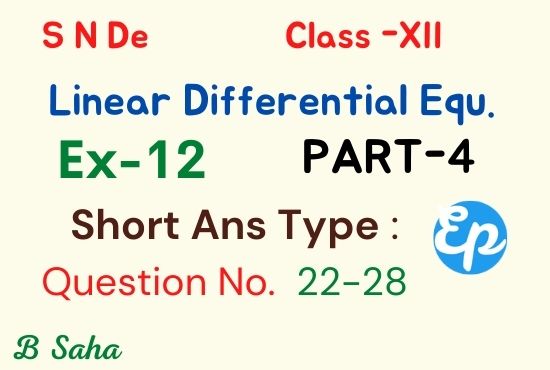$~22.~~(1+x)~\frac{dy}{dx}-xy=1-x$
Sol. $~~~~~(1+x)~\frac{dy}{dx}-xy=1-x \\ \Rightarrow \frac{dy}{dx}-\frac{x}{1+x}~y=\frac{1-x}{1+x}\rightarrow(1)$
I.F. of $\,(1)$
$=e^{\displaystyle\int{\frac{-x}{1+x}}~dx}\\=e^{\int{\left(\frac{1}{1+x}-1\right)~dx}}\\=e^{\log_e(1+x)-x}\\=(1+x)e^{-x}$
Now, multiplying both sides of $\,(1)\,$ by $~(1+x)e^{-x}~$ we get,
$~~~(1+x)e^{-x} \frac{dy}{dx}-xe^{-x}y=(1-x)e^{-x} \\ \Rightarrow \frac{d}{dx}[y(1+x)e^{-x}]=(1-x)e^{-x} \\ \therefore y(1+x)e^{-x}=\displaystyle\int{(1-x)e^{-x}~dx} \\ \text{or,}~~ y(1+x)e^{-x}=\displaystyle\int{e^{-x}~dx-\displaystyle\int{xe^{-x}~dx}} \\ \text{or,}~~ y(1+x)e^{-x}=-e^{-x}\\~~~~~~-\left(-xe^{-x}+\displaystyle\int{e^{-x}~dx}\right)\\ \text{or,}~~ y(1+x)e^{-x}=-e^{-x}+xe^{-x}+e^{-x}+c \\ \text{or,}~~ y(1+x)e^{-x}=xe^{-x}+c \\ \text{or,}~~ y(1+x)=x+ce^x~~~\text{(ans.)}$
$~23.~~(1-x^2)~\frac{dy}{dx}-xy=x^2,\\~~~\text{given}~~y=2~~\text{when}~~x=0.$
Sol. $~~~~(1-x^2)~\frac{dy}{dx}-xy=x^2 \\ \Rightarrow \frac{dy}{dx}-\frac{x}{1-x^2}=\frac{x^2}{1-x^2}\rightarrow(1)$
I.F. of $\,(1)$
$=e^{\displaystyle\int{\frac{-x}{1-x^2}}~dx}\\=e^{\frac 12 \log_e(1-x^2)}\\=e^{\log_e(1-x^2)^{1/2}}\\=\sqrt{1-x^2}$
Now, multiplying both sides of $\,(1)\,$ by $~x^2~$ we get,
$~~~\sqrt{1-x^2}~\frac{dy}{dx}-\frac{x}{\sqrt{1-x^2}}=\frac{x^2}{\sqrt{1-x^2}} \\ \Rightarrow \frac{d}{dx}(y\sqrt{1-x^2})=\frac{x^2}{\sqrt{1-x^2}} \\ \therefore y\sqrt{1-x^2}=\displaystyle\int{\frac{x^2}{\sqrt{1-x^2}}~dx} \\ \text{or,}~~y\sqrt{1-x^2}\\~~~~=\displaystyle\int{\left(\frac{1}{\sqrt{1-x^2}}-\sqrt{1-x^2}\right)~dx} \\ \text{or,}~~ y\sqrt{1-x^2}=\sin^{-1}x\\~~~~~-\left(\frac{x\sqrt{1-x^2}}{2}+\frac 12\sin^{-1}x\right)+c \\ \text{or,}~~ y\sqrt{1-x^2}=\frac 12(\sin^{-1}x-x\sqrt{1-x^2})\\~~~+c \rightarrow(2)$
Now, $~~y(0)=2 \Rightarrow c=2~~[\text{By (2)}]$
So, putting the value of $\,c\,$ in $\,(2)\,$ we get,
$~~y\sqrt{1-x^2}=\frac 12(\sin^{-1}x-x\sqrt{1-x^2})+2~~\text{(ans.)}$
$~24.~~\frac{dx}{dt}+x \cos t=\frac 12\sin2t$
Sol. $~~~\frac{dx}{dt}+x \cos t=\frac 12\sin2t \rightarrow(1)$
I.F. of $\,(1)$
$=e^{\displaystyle\int{\cos t}~dt}=e^{\sin t}.$
Now, multiplying both sides of $\,(1)\,$ by $~e^{\sin t}~$ we get,
$~~~e^{\sin t} ~\frac{dx}{dt}+x \cos t ~e^{\sin t}=\frac 12\sin2t~~e^{\sin t} \\ \Rightarrow \frac{d}{dt}(xe^{\sin t})=\frac 12\sin2t~e^{\sin t} \\ \therefore x e^{\sin t}=\frac 12\displaystyle\int{\sin2t~e^{\sin t}~dt} \\ \text{or,}~~ x e^{\sin t}=\displaystyle\int{\sin t\cos te^{\sin t}~dt} \\ \text{or,}~~ x~e^{\sin t}=\displaystyle\int{ze^z~dz}\\~~~~~[~~\text{let}~~\sin t=z \Rightarrow \cos t~dt=dz.] \\ \text{or,}~~ xe^{\sin t}=ze^z-e^z+c \\ \text{or,}~~ xe^{\sin t}=(\sin t)e^{\sin t}-e^{\sin t}+c \\ \text{or,}~~ x=\sin t-1+c e^{-\sin t}~~\text{(ans.)}$
$~25.~~\frac{dy}{dx}+\left(\tan x+\frac 1x\right)y=\frac{\sec x}{x}$
Sol. $~~~\frac{dy}{dx}+\left(\tan x+\frac 1x\right)y=\frac{\sec x}{x}\rightarrow(1)$
I.F. of $\,(1)$
$=e^{\displaystyle\int{\left(\tan x+\frac 1x\right)}~dx}\\=e^{\log_e\sec x+\log_e x}\\=e^{\log_e(x\sec x)}\\=x\sec x$
Now, multiplying both sides of $\,(1)\,$ by $~x\sec x~$ we get,
$~~~x \sec x~\frac{dy}{dx}+x\sec x\left(\tan x+\frac 1x\right)y\\~~~=x\sec x \cdot \frac{\sec x}{x}\\ \Rightarrow x\sec x~\frac{dy}{dx}+(x \sec x\tan x +\sec x)y\\~~~=\sec^2x \\ \Rightarrow \frac{d}{dx}(yx\sec x)=\sec^2x \\ \therefore yx \sec x=\displaystyle\int{\sec^2x~dx}\\ \Rightarrow xy \sec x =\tan x+c~~\text{(ans.)} $
$~26.~~\frac{dy}{dx}+2y\tan x=\sin x;\\~~\text{given}~~y=0~~\text{when}~~x=\pi/3.$
Sol. $~~~\frac{dy}{dx}+2y\tan x=\sin x\rightarrow(1)$
I.F. of $\,(1)$
$=e^{\displaystyle2\int{\tan x}~dx}\\=e^{2\log_e(\sec x)}\\=e^{\log_e(\sec x)^2}\\=\sec^2 x$
Now, multiplying both sides of $\,(1)\,$ by $~\sec^2 x~$ we get,
$~~~\sec^2x~p+2y \tan x\sec^2x=\sin x\sec^2x\\ \Rightarrow \frac{d}{dx}(y \sec^2x)=\sec x\tan x \\ \therefore y\sec^2x=\displaystyle\int{\sec x\tan x~dx} \\ \Rightarrow y\sec^2x=\sec x+c \\ \Rightarrow y=\cos x+c\cos^2x\rightarrow(2)$
Now, $~~~y(\pi/3)=0~~~\text{(given)}$
$~~\therefore 0=\frac 12+c \cdot \frac 14 \Rightarrow c=-2~~[\text{By (2)}]$
Finally, putting the value of $~c~$ in $\,(2)\,$ we get,
$~~y=\cos x-2\cos^2x~~~\text{(ans.)}$
$~27.~~\frac{dy}{dx}=\frac{x\sqrt{x^2-1}+y}{\sqrt{x^2-1}}$
Sol. $~~~~\frac{dy}{dx}=\frac{x\sqrt{x^2-1}+y}{\sqrt{x^2-1}} \\ \Rightarrow \frac{dy}{dx}-\frac{1}{\sqrt{x^2-1}}~y=x \rightarrow(1)$
I.F. of $\,(1)$
$=e^{\displaystyle\int{\left(\frac{-1}{\sqrt{x^2-1}}\right)}~dx}\\=e^{-\log_e(x+\sqrt{x^2-1})}\\=\frac{1}{x+\sqrt{x^2-1}}\\=x-\sqrt{x^2-1}$
Now, multiplying both sides of $\,(1)\,$ by $~(x-\sqrt{x^2-1})~$ we get,
$~~(x-\sqrt{x^2-1})~\frac{dy}{dx}-(x-\sqrt{x^2-1})~\frac{y}{\sqrt{x^2-1}}\\~~~=x(x-\sqrt{x^2-1})\\ \Rightarrow (x-\sqrt{x^2-1})~\frac{dy}{dx}+\left(1-\frac{x}{\sqrt{x^2-1}}\right)\\~~~=x(x-\sqrt{x^2-1}) \\ \therefore \frac{d}{dx}\{y(x-\sqrt{x^2-1})\}=x^2-x\sqrt{x^2-1} \\ \Rightarrow y(x-\sqrt{x^2-1})=\displaystyle\int{(x^2-x\sqrt{x^2-1})~dx} \\ \Rightarrow y(x-\sqrt{x^2-1})\\~~~=\displaystyle\int{x^2~dx}-\int{x\sqrt{x^2-1}~dx} \\ \Rightarrow y(x-\sqrt{x^2-1})\\~~~=\frac{x^3}{3}-\frac 12 \displaystyle\int{\sqrt{x^2-1}~d(x^2)} \\ \Rightarrow y(x-\sqrt{x^2-1})\\~~~=\frac{x^3}{3}-\frac 12 \cdot \frac{(x^2-1)^{3/2}}{3/2}+c \\ \Rightarrow y(x-\sqrt{x^2-1})\\~~~=\frac{x^3}{3}-\frac{(x^2-1)^{3/2}}{3}+c \rightarrow(2)$
Now, $~~y(1)=1~~\text{(given)}$
So, $~~1=\frac 13-0+c \Rightarrow c=\frac 23~~\text{By (2)}]$
Finally, putting the value of $\,c\,$ in $\,(2)\,$ we get,
$~~~y(x-\sqrt{x^2-1})=\frac{x^3}{3}-\frac{(x^2-1)^{3/2}}{3}+\frac 23 \\ \text{or,}~~y(x-\sqrt{x^2-1})=\frac 13\left[x^3-(x^2-1)^{3/2}\right]\\~~~+\frac 23~~\text{(ans.)}$
$~28.~~x(1-x^2)~dy+(2x^2y-y-5x^3)~dx=0$
Sol. $~~~x(1-x^2)~dy+(2x^2y-y-5x^3)~dx=0\\ \text{or,}~~\frac{dy}{dx}+\frac{2x^2-1}{x(1-x^2)}~y=\frac{5x^2}{1-x^2} \rightarrow(1)~~$
and it is of the form of $~\frac{dy}{dx}+Py=Q,~$
where $~P=-\frac{2}{x+1},~Q=(x+1)^3.$
At first, we calculate the following:
$~~~~~~~\frac{2x^2-1}{x-x^3}\\=-\frac{1-2x^2}{x(1-x^2)}\\=-\frac{(1-x^2)-x^2}{x(1-x^2)}\\=-\left[\frac{1}{x}-\frac 12 \cdot \frac{2x}{1-x^2}\right]\\=-\left[\frac 1x-\frac 12\cdot \frac{(1+x)-(1-x)}{(1+x)(1-x)}\right]\\=-\frac 1x+\frac 12\left(\frac{1}{1-x}-\frac{1}{1+x}\right)\rightarrow(2)$
Now, $~\displaystyle\int{P~dx}\\=\displaystyle\int{\frac{2x^2-1}{x-x^3}~dx}~~\\=-\displaystyle\int{\frac{dx}{x}}+\frac 12 \int{\frac{dx}{1-x}}-\frac 12 \int{\frac{dx}{1+x}}\\~~~~~~~~[\text{By (2)}]\\=-\log x-\frac 12\log(1-x)-\frac 12\log(1+x)\\=-\frac 12[2\log x+\log(1-x)+\log(1+x)]\\=-\frac 12[\log x^2+\log\{(1-x)(1+x)\}]\\=-\frac 12[\log x^2+\log(1-x^2)]\\=-\frac 12[\log\{x^2(1-x^2)\}]\\=\log [x^2(1-x^2)]^{-1/2}$
$~\therefore~\text{I.F.}=e^{\int{P~dx}}\\~~~~~~~~~~~~~=e^{\log [x^2(1-x^2)]^{-1/2}}\\~~~~~~~~~~~~~=\frac{1}{x\sqrt{1-x^2}}$
Now, multiplying both sides of $\,(1)\,$ by $~\frac{1}{x\sqrt{1-x^2}}~$ we get,
$~~\frac{1}{x\sqrt{1-x^2}}~\frac{dy}{dx}+\frac{2x^2-1}{x(1-x^2)} \cdot \frac{1}{x\sqrt{1-x^2}}~y\\~~~=\frac{5x^2}{(1-x^2)} \cdot \frac{1}{x\sqrt{1-x^2}} \\ \therefore \frac{d}{dx}\left( y\cdot \frac{1}{x\sqrt{1-x^2}}\right)=\frac{5x}{(1-x^2)\sqrt{1-x^2}} \\ \Rightarrow y \cdot \frac{1}{x\sqrt{1-x^2}}=\displaystyle\int{\frac{5x}{(1-x^2)^{3/2}}~dx} \\ \Rightarrow \frac{y}{x\sqrt{1-x^2}}=\frac{5}{\sqrt{1-x^2}}+c~~[*] \\ \therefore y=5x+cx\sqrt{1-x^2}~~\text{(ans.)}$
Note[*] : $~~I=\displaystyle\int{\frac{x}{(1-x^2)^{3/2}}~dx}\\=-\displaystyle\int{\frac{z~dz}{z^3}}~~~[~~\text{let}~~1-x^2=z^2 \\~~~~~~~~~~~~~ \Rightarrow -2x~dx=2z~dz \\~~~~~~~~~~~~~ \Rightarrow x~dx=-z~dz]\\=-\displaystyle\int{\frac{dz}{z^2}}\\=-\left(\frac{z^{-2+1}}{(-2+1)}\right)\\=\frac 1z\\=\frac{1}{\sqrt{1-x^2}}$










Please do not enter any spam link in the comment box